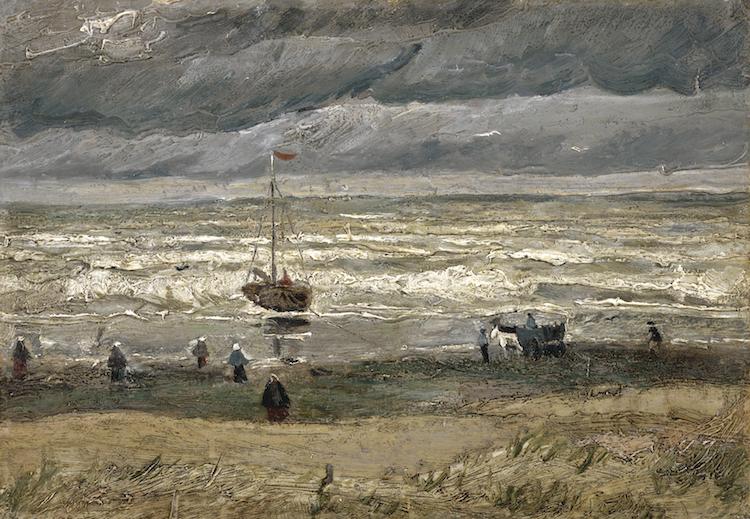
“The Harvest” (1888) (Photo: Wikimedia Commons [Public domain])
From Monet's Water Lilies to Paul Cezanne‘s French landscapes, artists have always been inspired by their surroundings. Vincent Van Gogh was no exception. He lived in over 15 different cities across Europe during his short, 37-year life, searching for both artistic inspiration, but also for a place to calm his busy mind. In a letter to his brother Theo in August 1888 he wrote, “It always seems to me that I’m a traveler who’s going somewhere and to a destination.”
Van Gogh’s huge body of work is like a timeline, revealing where he traveled, the places he lived, and his state of mind at the time. Each location not only provided inspiration, but also shaped his style and influenced his productivity. From the Dutch seaside to the French countryside, here are 5 places that shaped Van Gogh’s life and work.
5 Places That Inspired Vincent van Gogh’s Paintings
The Hague, The Netherlands

“View of the Sea at Scheveningen” (1882). (Photo: Wikimedia Commons [Public domain])
Van Gogh was particularly influenced by Anthonij Rudolf Mauve—a Dutch realist painter who was a leading member of the Hague School. At the end of 1881 when van Gogh was in his late twenties, the young artist spent 3 weeks at Mauve's studio. During this time he started experimenting with color and texture for the first time, often creating thick, impasto paintings in oil. One of these early canvases includes View of the Sea at Scheveningen (1882), depicting a gray, windy day at the seaside near his home at the time. It was so windy in fact, that grains of sand are still embedded in the painting’s surface today, evidence that Van Gogh painted it en plein air that day.
Nuenen, The Netherlands

“Autumn Landscape” (1885). (Photo: Wikimedia Commons [Public domain])
Although busy, Van Gogh was unable to sell his work, so he became financially dependent on his brother Theo who was working as an art dealer in Paris. They agreed that every painting Van Gogh made would be Theo’s property in return for 150 francs every month.
Without financial pressure, Van Gogh felt free to experiment even more with color and thick brushwork. One of the last pieces he made while in Neuen was Autumn Landscape (1885), which displayed his growing confidence in composition, color, and light. “My palette is thawing,” he wrote to Theo around the time he completed the piece, “and the bleakness of the earliest beginnings has gone.”
Paris, France

“Self-Portrait with Gray Felt Hat” (1887). (Photo: Wikimedia Commons [Public domain])
As well as depicting Parisian parks and street scenes, Van Gogh completed two of his most famous self-portraits during his stint in the city—Self-Portrait with Black Felt Hat (1887) and Self-Portrait with Gray Felt Hat (1887). Painted less than a year apart, it’s clear to see how fast the artist’s own unique colorful style developed during this short time.
Arles, France

“The Red Vineyard at Arles” (1888). (Photo: Wikimedia Commons [Public domain])
Surrounded by the Provencal countryside’s wheat fields, vineyards, and fields of sunflowers, Van Gogh became so inspired that he painted around 200 pieces during his 15 month stay—that’s more than 3 per week! Works such as Harvest in Provence, The Sower, and The Red Vineyard at Arles (all 1888) are characterized by bold colors and dynamic brushstrokes, signifying his happy state of mind.

“Self-portrait with Bandaged Ear” (1889). (Photo: Wikimedia Commons [Public domain])
Saint-Paul-de-Mausole, Saint-Rémy-de-Provence, France

“Starry Night” (1889). (Photo: Wikimedia Commons [Public domain])
Featuring a dark sky, shimmering stars, and a glowing moon swirling above a small village, it depicts the view from the east-facing window of his asylum room, just before sunrise. It reveals that even through Van Gogh’s toughest times, he was committed to his craft. In Living with Vincent van Gogh: The homes and landscapes that shaped the artist (2019), scholar and curator Martin Bailey writes, “This vibrant painting stands as a powerful testament to the artist’s struggle to overcome the challenges of living and working in an asylum for the insane.”
However, just a year later in 1890, Van Gogh decided to end his mental suffering and sadly took his own life in the small town of Auvers in northern France. Although his life was short and turbulent, Van Gogh’s 850 paintings and 1,300 drawings showcase his passion and creative determination for life and art, making him one of the most celebrated artists of all time.
Related Articles:
Van Gogh: How the Post-Impressionist’s Work Evolved During His Short Life
How Van Gogh’s Love of Painting Sunflowers Blossomed During His Short Career
The Fascinating Story Behind the Painting That Led to Van Gogh’s ‘Starry Night’
How Van Gogh’s ‘The Starry Night’ Came to Be and Continues to Inspire Artists
Beautiful Van Gogh Notecards Let You Channel the Artist’s Love of Letter-Writing






















































































